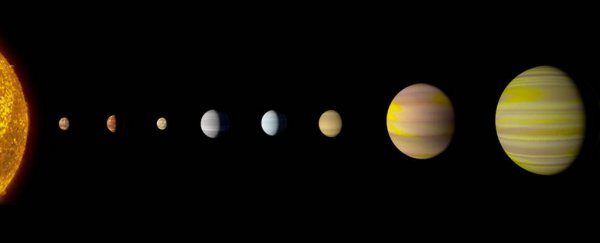NASA and Google announced a "major discovery" on Thursday: another solar system with eight planets.
That finding is due to the discovery of a new planet, Kepler-90i - a hot, rocky orb circling a sun-like star called Kepler-90, which is 2,545 light-years from Earth.
The planet was found using a machine-learning system from Google, which was put to work sifting through data from NASA's Kepler spacecraft.
Kepler, a space telescope that trails Earth in orbit around the sun, has stared down 145,000 sun-like stars over the years to look for signs of distant planets.
Astronomers knew about the Kepler-90 solar system, but had not previously detected this planet. It appears to be the third planet from the sun-like star, and orbits roughly every 14 days. The temperature on Kepler-90i surface is likely around 1,800 degrees Fahrenheit (980 degrees Celsius).
"Kepler-90i is not a place I'd like to go visit," Andrew Vanderburg, an astronomer at the University of Texas at Austin who helped find the planet, said during a press briefing.
Vanderburg was aided in the work by Google AI software engineer Christopher Shallue.
"The way I see it, what we've developed here is a tool to help astronomers have more impact," Shallue said.
Vanderburg and Shallue also found a second new planet, called Kepler 80g.
To detect these two new worlds, Google's machine learning learned how to identify signals from exoplanets recorded in the Kepler data.
It processed 14 billion data points from four years' worth of Kepler images, using what's known as a convolutional neural network, which sort of mimics the way the human brain processes information.
NASA and Google say this new technology will help scientists find many more such exoplanets in the future. In fact, Vanderburg believes the Kepler-90 solar system likely has more planets that we haven't yet detected.
"It would almost be surprising to me if there weren't any more," he said. "Is an eight-planet solar system like our own really that extraordinary? Maybe there are systems out there with so many planets, they make our solar system seem ordinary."

Prior to this analysis, NASA's last examination of Kepler data confirmed 219 new worlds in the more than 4,000 candidates that Kepler had turned up.
The space agency's current total of confirmed exoplanets is now 2,525 - and 10 of those may be rocky, Earth-size, and possibly habitable to alien life.
For those wondering whether Google's AI system could make astronomers obsolete, NASA says not to worry.
Jessie Dotson, a Kepler project scientist at NASA's Ames Research Center in Silicon Valley, explained that astronomers will always be needed to classify objects before feeding information into a neural network, so that the AI can learn how to look at new data.
"This will absolutely work alongside astronomers," Dotson said. "You're never going to take that piece out."
This article was originally published by Business Insider.
More from Business Insider:
